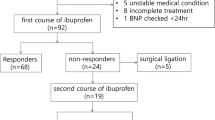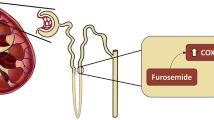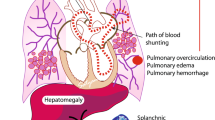Abstract
Objective:
Patent ductus arteriosus (PDA) is common in preterm infants and is associated with significant morbidities. B type natriuretic peptide (BNP) is synthesized in the ventricles secondary to volume overload and excreted as urinary N-terminal pro-brain natriuretic peptide (NT-proBNP).
Study Design:
We report an observational prospective study of 64 preterm infants with birth weight ⩽1000 g. Echocardiographic parameters were obtained from clinical echocardiograms performed in the first week of life. Urinary NT-proBNP/creatinine ratios (pg mg−1) were measured on the same day of the echocardiograms.
Results:
Infants with medium to large PDA (n=39) had significantly higher NT-proBNP/creatinine levels compared with infants with small PDA (n=10) (median (IQ range): 2333 (792–6166) vs 714 (271–1632) pg mg−1, P=0.01) and compared with infants with no PDA (n=15) (2333 (792–6166) vs 390 (134–1085) pg mg−1, P=0.0003). Urinary NT-proBNP/creatinine ratios were significantly lower post treatment if PDA closed (n=17), P=0.001 or if PDA became smaller after treatment (n=9), P=0.004. Urinary NT-proBNP/creatinine levels correlated with ductal diameter (P⩽0.0001), but not with LA/Ao ratio (P=0.69) or blood flow velocity through the ductus (P=0.06).
Conclusion:
Our findings indicate that there is a positive correlation between ductal diameter and urinary NT-proBNP in preterm infants.
This is a preview of subscription content, access via your institution
Access options
Subscribe to this journal
Receive 12 print issues and online access
$259.00 per year
only $21.58 per issue
Buy this article
- Purchase on Springer Link
- Instant access to full article PDF
Prices may be subject to local taxes which are calculated during checkout




Similar content being viewed by others
References
Costeloe K, Hennessy E, Gibson AT, Marlow N, Wilkinson AR . The EPICure study: outcomes to discharge from hospital for infants born at the threshold of viability. Pediatrics 2000; 106 (4): 659–671.
Kluckow M, Evans N . Ductal shunting, high pulmonary blood flow, and pulmonary hemorrhage. J Pediatr 2000; 137 (1): 68–72.
Todd DA, Jana A, John E . Chronic oxygen dependency in infants born at 24-32 weeks' gestation: the role of antenatal and neonatal factors. J Paediatr Child Health 1997; 33 (5): 402–407.
Marshall DD, Kotelchuck M, Young TE, Bose CL, Kruyer L, O'Shea TM . Risk factors for chronic lung disease in the surfactant era: a North Carolina population-based study of very low birth weight infants. North Carolina Neonatologists Association. Pediatrics 1999; 104 (6): 1345–1350.
Cassady G, Crouse DT, Kirklin JW, Strange MJ, Joiner CH, Godoy G et al. A randomized, controlled trial of very early prophylactic ligation of the ductus arteriosus in babies who weighed 1000 g or less at birth. N Engl J Med 1989; 320 (23): 1511–1516.
John E, Todd DA . Patent ductus arteriosus and retinopathy of prematurity in infants below 27 weeks gestation. Aust Paediatr J 1988; 24 (3): 171–173.
Kwinta P, Rudzinski A, Kruczek P, Kordon Z, Pietrzyk JJ . Can early echocardiographic findings predict patent ductus arteriosus? Neonatology 2009; 95 (2): 141–148.
Kluckow M, Seri I, Evans N . Functional echocardiography: an emerging clinical tool for the neonatologist. J Pediatr 2007; 150 (2): 125–130.
Chiruvolu A, Jaleel MA . Pathophysiology of patent ductus arteriosus in premature neonates. Early Hum Dev 2009; 85 (3): 143–146.
Koch J, Hensley G, Roy L, Brown S, Ramaciotti C, Rosenfeld CR . Prevalence of spontaneous closure of the ductus arteriosus in neonates at a birth weight of 1000 grams or less. Pediatrics 2006; 117 (4): 1113–1121.
Hobbs FD, Jones MI, Allan TF, Wilson S, Tobias R . European survey of primary care physician perceptions on heart failure diagnosis and management (Euro-HF). Eur Heart J 2000; 21 (22): 1877–1887.
Hasegawa K, Fujiwara H, Doyama K, Miyamae M, Fujiwara T, Suga S et al. Ventricular expression of brain natriuretic peptide in hypertrophic cardiomyopathy. Circulation 1993; 88 (2): 372–380.
Farombi-Oghuvbu I, Matthews T, Mayne PD, Guerin H, Corcoran JD . N-terminal pro-B-type natriuretic peptide: a measure of significant patent ductus arteriosus. Arch Dis Child Fetal Neonatal Ed 2008; 93 (4): F257–F260.
Gobinet-Georges A, Valli N, Filliatre H, Dubernet MF, Dedeystere O, Bordenave L . Stability of brain natriuretic peptide (BNP) in human whole blood and plasma. Clin Chem Lab Med 2000; 38 (6): 519–523.
Shimizu H, Aono K, Masuta K, Asada H, Misaki A, Teraoka H . Stability of brain natriuretic peptide (BNP) in human blood samples. Clin Chim Acta 1999; 285 (1–2): 169–172.
Kemperman H, van den Berg M, Kirkels H, de Jonge N . B-type natriuretic peptide (BNP) and N-terminal proBNP in patients with end-stage heart failure supported by a left ventricular assist device. Clin Chem 2004; 50 (9): 1670–1672.
Tosse V, Pillekamp F, Verde P, Hadzik B, Sabir H, Mayatepek E et al. Urinary NT-proBNP, NGAL, and H-FABP may predict hemodynamic relevance of patent ductus arteriosus in very low birth weight infants. Neonatology 2012; 101 (4): 260–266.
Letzner J, Berger F, Schwabe S, Benzing J, Morgenthaler NG, Bucher HU et al. Plasma C-terminal pro-endothelin-1 and the natriuretic pro-peptides NT-proBNP and MR-proANP in very preterm infants with patent ductus arteriosus. Neonatology 2012; 101 (2): 116–124.
Ramakrishnan S, Heung YM, Round J, Morris TP, Collinson P, Williams AF . Early N-terminal pro-brain natriuretic peptide measurements predict clinically significant ductus arteriosus in preterm infants. Acta Paediatr 2009; 98 (8): 1254–1259.
Nuntnarumit P, Khositseth A, Thanomsingh P . N-terminal probrain natriuretic peptide and patent ductus arteriosus in preterm infants. J Perinatol 2009; 29 (2): 137–142.
Czernik C, Lemmer J, Metze B, Koehne PS, Mueller C, Obladen M . B-type natriuretic peptide to predict ductus intervention in infants <28 weeks. Pediatr Res 2008; 64 (3): 286–290.
Hsu JH, Yang SN, Chen HL, Tseng HI, Dai ZK, Wu JR . B-type natriuretic peptide predicts responses to indomethacin in premature neonates with patent ductus arteriosus. J Pediatr 2010; 157 (1): 79–84.
El-Khuffash AF, Amoruso M, Culliton M, Molloy EJ . N-terminal pro-B-type natriuretic peptide as a marker of ductal haemodynamic significance in preterm infants: a prospective observational study. Arch Dis Child Fetal Neonatal Ed 2007; 92 (5): F421–F422.
Jungbauer CG, Buchner S, Birner C, Resch M, Heinicke N, Debl K et al. N-terminal pro-brain natriuretic peptide from fresh urine for the biochemical detection of heart failure and left ventricular dysfunction. Eur J Heart Fail 2010; 12 (4): 331–337.
Cortes R, Portoles M, Salvador A, Bertomeu V, Garcia de Burgos F, Martinez-Dolz L et al. Diagnostic and prognostic value of urine NT-proBNP levels in heart failure patients. Eur J Heart Fail 2006; 8 (6): 621–627.
Kluckow M, Evans N . Early echocardiographic prediction of symptomatic patent ductus arteriosus in preterm infants undergoing mechanical ventilation. J Pediatr 1995; 127 (5): 774–779.
Czernik C, Metze B, Muller C, Muller B, Buhrer C . Urinary N-terminal B-type natriuretic peptide predicts severe retinopathy of prematurity. Pediatrics 2011; 128 (3): e545–e549.
Czernik C, Metze B, Muller C, Buhrer C . Urinary NT-proBNP and ductal closure in preterm infants. J Perinatol 2013; 33 (3): 212–217.
Celik IH, Erdeve O, Demirel G, Canpolat FE, Dilmen U . Elevated urinary NT-proBNP after pharmacological closure of patent ductus arteriosus in very low birth weight infants. Early Hum Dev 2013; 89 (3): 187–189.
Linssen GC, Damman K, Hillege HL, Navis G, van Veldhuisen DJ, Voors AA . Urinary N-terminal prohormone brain natriuretic peptide excretion in patients with chronic heart failure. Circulation 2009; 120 (1): 35–41.
Ng LL, Geeranavar S, Jennings SC, Loke I, O'Brien RJ . Diagnosis of heart failure using urinary natriuretic peptides. Clin Sci (Lond) 2004; 106 (2): 129–133.
Kroll MH, Srisawasdi P . The clearance of BNP modeled using the NT-proBNP-BNP relationship. Biosystems 2007; 88 (1-2): 147–155.
Daniels LB, Maisel AS . Natriuretic peptides. J Am Coll Cardiol 2007; 50 (25): 2357–2368.
Toyoshima K, Momma K, Imamura S, Nakanishi T . In vivo dilatation of the postnatal ductus arteriosus by atrial natriuretic peptide in the rat. Neonatology 2007; 92 (2): 139–144.
Kulkarni M, Gokulakrishnan G, Price J, Fernandes CJ, Leeflang M, Pammi M . Diagnosing significant PDA using natriuretic peptides in preterm neonates: a systematic review. Pediatrics 2015; 135 (2): e510–e525.
Acknowledgements
The project described was supported by the National Center for Advancing Translational Sciences, UL1TR000117, the Dean of the College of Medicine, University of Kentucky and Children’s Miracle Network (CMN) grant awarded to Kentucky Children’s Hospital. We thank our research nurses Vicky Whitehead and Deb Grider for their assistance.
Author information
Authors and Affiliations
Corresponding author
Ethics declarations
Competing interests
The authors declare no conflict of interest.
Rights and permissions
About this article
Cite this article
Khan, S., Sithisarn, T., Bada, H. et al. Urinary NT-proBNP levels and echocardiographic parameters for patent ductus arteriosus. J Perinatol 37, 1319–1324 (2017). https://doi.org/10.1038/jp.2017.139
Received:
Revised:
Accepted:
Published:
Issue Date:
DOI: https://doi.org/10.1038/jp.2017.139
This article is cited by
-
NT-PROBNP as a screening tool for low-risk patent ductus arteriousus: a follow-up validation study
European Journal of Pediatrics (2023)
-
Photoplethysmographic assessment of pulse transit time correlates with echocardiographic measurement of stroke volume in preterm infants with patent ductus arteriosus
Journal of Perinatology (2018)



